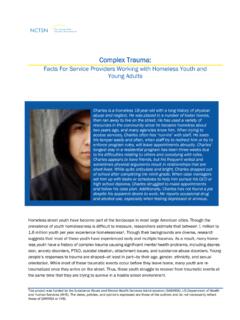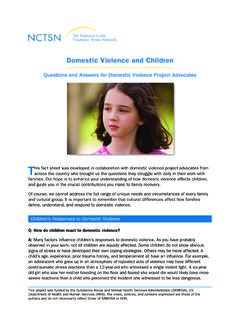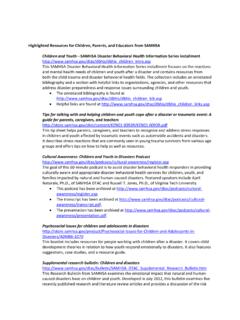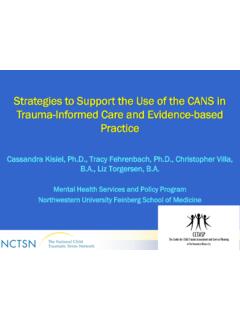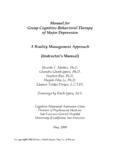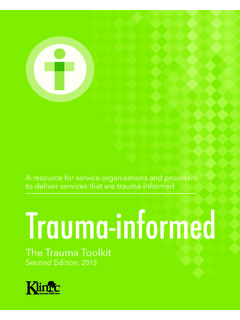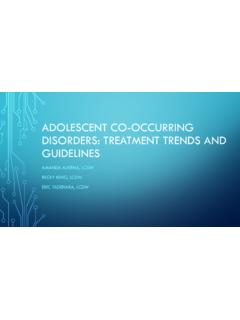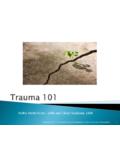Transcription of NCTSN Fact Sheet Template - fyca.org
1 This project was funded by the Substance Abuse and Mental Health Services Administration (SAMHSA), US Department of Health and Human Services (HHS). The views, policies, and opinions expressed are those of the authors and do not necessarily reflect those of SAMHSA or HHS. Complex Trauma: In Juvenile Justice System-Involved Youth As Elizabeth s story illustrates, youth who come to the attention of law enforcement and become involved in the juvenile justice system are often experiencing the after-effects of years of exposure to complex interpersonal trauma.
2 These youth have faced repeated threats to their lives or the lives of people closest to them. Losing key people in their lives, and experiencing betrayals of trust and abandonment from caregivers, compound the violations of the basic social contract that every youth should have an equal opportunity to have a successful life as a valued member of society. These survival threats and painful emotional (and often also physical) injuries are a part of daily life and second nature for too many youth who become involved with law enforcement and juvenile justice.
3 They also are forms of complex trauma that can have lifelong adverse effects. More than two-thirds of youth involved with law enforcement or juvenile justice have complex histories of interpersonal trauma, including exposure to neglect, emotional, physical, and sexual abuse, family and community violence, traumatic losses, and disrupted relationships with primary caregivers (Ford, et al., 2013). Many also come from families in which caregivers and siblings are coping with other adversities such as substance abuse, mental health problems, unemployment, or discrimination based on race, ethnicity, sexual identity, or disability, legal problems, or incarceration).
4 Youth from ethnic and racial minorities and those from low-income backgrounds are disproportionately involved in the juvenile justice system and subject to these additional adversities. Elizabeth is a 17-year-old Hispanic female whose father was murdered by a drug dealer when she was three years old. After his death, she, her mother, stepfather, and two older sisters lived together in an economically disadvantaged neighborhood. Her stepfather, who left when she turned 12, physically and verbally abused Elizabeth and her other family members.
5 Elizabeth s mother was also verbally and physically abusive toward her. Elizabeth also remembers being bullied in elementary school. In addition to the direct maltreatment she experienced, she has known several female family members and friends including her sister and her best friend from preschool who were sexually assaulted. Elizabeth first began affiliating with gangs when she was 12 years old and considered them her real family. She started smoking marijuana heavily after joining the gang and used multiple other substances to get high.
6 At age 13, she assaulted another teen and received 18 months of house arrest. She reports that she blacked out during this incident and doesn t remember much of it. She later discovered that she had broken the youth s nose and arm. Despite her lack of recall about that assault, however, she reports that she is haunted by the image of seeing someone shot in the head and watching him die. At the age of 16, she was convicted of drug- and weapons-related offenses and was sentenced to a youth detention center for a year.
7 At the time, she reported that beating people up was part of her gang s expectations for belonging. 2 Complex Trauma in Juvenile Justice System-Involved Youth March 2017 PATHWAYS FROM COMPLEX TRAUMA TO INVOLVEMENT IN JUVENILE JUSTICE AND RECIDIVISM The pathways from complex trauma exposure to involvement in juvenile justice and recidivism are correspondingly complex and variable. One common denominator is the adoption of an unstated code of behavior. This survival code differs from the established rules of the majority society, and is a direct consequence of traumatic stress on emotional, physiological, and behavioral factors which place youth at increased risk of committing offenses.
8 The experience of complex trauma violates the social contract that lies at the heart of societal laws and structures: the unspoken contract that says that good deeds and behavior are rewarded, that perpetrating harm should and will be punished, and that maintaining order is mutually beneficial. For youth who have experienced repeated violence, violation, exploitation, rejection, and abandonment in their homes, schools, and communities, safety and justice seem impossible to obtain. As a result, the rubric of survival ( What do I have to do to survive?)
9 Is likely to trump legality ( Is this behavior appropriate within the laws of my community and society? ). A second common denominator for youth with complex trauma histories who are involved with law enforcement or juvenile justice is difficulty in effectively managing emotions, physical reactions, impulses, attention, consequential thinking ( , problem-solving and decision-making based on an awareness of and accurate evaluation of consequences), and involvement in interpersonal relationships ( , ranging from extreme isolation to enmeshment in dangerous or exploitive relationships).
10 These are the building blocks for self-regulation, the ability to draw on one s own inner strengths and genuinely supportive relationships in order to channel motivation, manage distress, and think effectively. The development in childhood of these self-regulation capacities is severely undermined by complex trauma. As a result, these youth often have problems in school, family relationships, and with substance abuse, sexualized behaviors, risky or reckless behavior, delinquency, and running away. On the surface, these behaviors may appear to be motivated by disregard for their own or others safety and well-being and the law, but actually they are attempts to cope with or prevent further traumatization.

